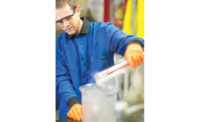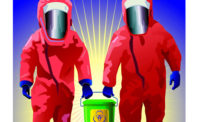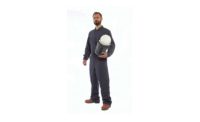The construction industry continues to be one of the most dangerous in the nation1. In 2021, the industry was responsible for approximately 1 in 5 workplace fatalities, and workers face a number of risks that can lead to injuries as well. Construction accounted for a total of 46.2% of all workplace accidents resulting from slips, trips, and falls in 20212.
The safety hazards on jobsites cannot be overstated, yet the head protection available to workers has seen little improvement over the past several decades.
The history of the hard hat
To get a sense of the personal protective equipment (PPE) available to workers today, it helps to take a look at the very first hard hats. Dating back to World War I, hard hats were first introduced when the U.S. built ships for the Navy: The Hard-Boiled Hard Hat was developed out of boiled leather and metal in 1919. Inner suspensions were added in 1928, which were designed to help absorb the impact of dropped objects. Throughout the 1930s and 40s, helmets made from aluminum and fiberglass were created, before the plastic hard hat, which debuted in 1951.
Helmets have seen a variety of updates in the years since, from attachments for face shields, hearing protection, and integrated eyewear, to rated chinstraps. However, beyond these functional updates, mostly in terms of useful accessories, helmets have changed relatively little from those that were first created in the twentieth century.
Today’s helmet options
While some workers are unsure of why helmets must be worn and the protection they can provide against traumatic brain injuries (TBIs), there is often confusion surrounding the differences between Type I and Type II helmets, and what they’re designed to protect against.
Under the current ANSI/ISEA Z89.1 standard, the two types of helmets available are Type I and Type II. Type I helmets are meant to protect wearers from the force of impact to the top of the head and helmet. Type II helmets are also designed to protect wearers from impacts to the top of the head, in addition to reducing the force of lateral, or side, impacts from blows that could be off center. Depending on the work you do, you may also want to pay special attention to the helmet classification, as the helmet classification indicates its electrical performance. The three classes of helmets include G, general; E, electrical; and C, conductive. Class G helmets are designed to reduce exposure to low voltage conductors; Class E are designed to reduce exposure to high voltage conductors; Class C provides vented options and is not intended to add protection against contact with electrical conductors.
Helmets under the ANSI/ISEA Z89.1 standard must meet five performance tests to obtain their classification. The tests include flammability, force transmission, apex penetration, impact energy attenuation, and electrical insulation. The force transmission test concludes whether helmets reduce the force of linear impact to the top of the head, while energy attenuation tests determine whether helmets reduce the force of linear impacts to the front, rear, and sides of the helmet as well.
However, it’s important to note that these tests only determine the impact of linear forces. Here’s why that’s a problem.
Rotational motion and traumatic brain injuries
Traumatic brain injuries, or TBIs, are injuries that can impact how the brain functions. TBIs can lead to short-term issues, impacting how someone thinks, moves, or communicates, long-term issues including disabilities, and even death.
For the construction industry, accidents such as slips, trips, and falls are a crucial concern. When someone’s head makes impact with an object or the ground, research demonstrates that this typically occurs at an angle, and therefore exposes them to something called rotational motion. The combination of rotational energy (angular velocity) and rotational forces (angular acceleration), rotational motion can result from oblique impacts to the head. When rotational motion is transferred to the head, it can result in shearing and subsequent damage to the brain’s axons, the cable transmitters of the neurons3.
Research has shown that the brain is more sensitive to rotational motion than linear motion regarding concussions.
Research has shown that the brain is more sensitive to rotational motion than linear motion regarding concussions4. Simply put, if rotation is a factor, concussions can occur even from seemingly light impacts.
Different types of impacts to the head can lead to different types of injuries. For example, rotational motion can result in diffuse injuries, such as diffuse axonal injury and subdural hematoma. Linear injuries, injuries that result from straight impacts to the head, can lead to focal injuries, such as fractures and contusions. In most accidents, linear and rotational motion commonly occur simultaneously, which can potentially lead to greater risk of injury3,5.
Why this is an issue with today’s PPE
Currently, no tests are being done to determine the impact of rotational motion on the helmet wearer’s head in today’s standards for hard hats and safety helmets. We have begun to see rotational motion being taken into account in the sports and moto industries, but the construction industry has not applied such tests.
For those in the construction industry, it’s important to know what PPE is available, and how it can potentially protect against the risks of the job. Many employers now require Type II helmets to be worn, and many also require the inclusion of chinstraps. These helmets provide an added layer of safety compared to Type I helmets, which rarely include chinstraps, and often fail to protect workers from slips, trips, and falls as they can easily fall off the wearer’s head.
However, it is crucial to note that neither Type I or Type II helmets address the potential impact of rotational motion. Workers should take into consideration whether their helmets are designed to address rotational motion.
While the standards haven’t changed much in recent years, research and reports continue to indicate the harmful effects of rotational motion as well as the importance of a well-fitted helmet while on the job.
References
- https://injuryfacts.nsc.org/work/industry-incidence-rates/most-dangerous-industries/
- https://www.bls.gov/opub/ted/2023/construction-deaths-due-to-falls-slips-and-trips-increased-5-9-percent-in-2021.htm
- Gennarelli et.al. (1987). “Directional dependence of axonal brain injury due to centroidal and non-centroidal acceleration,” in Proceedings of the 31st Stapp Car Crash Conference (Warrendale, PA: Society of Automotive Engineers).
- Kleiven, S (2007). “Predictors for traumatic brain injuries evaluated through accident reconstructions,” Stapp Car Crash J, vol. 51, pp. 81–114, Oct. 2007.
- Gennarelli et. al. (1972). “Pathophysiological responses to rotational and translational accelerations of the head,” in Proceedings of the 16th Stapp Car Crash Conference, 1972 (Warrendale, PA: Society of Automotive Engineers).



